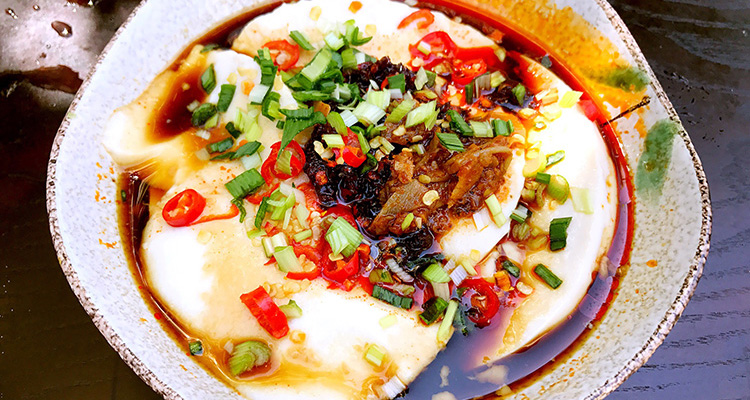Dianjiang Stone-Milled Tofu Pudding: Chongqing’s Classic Flavor
Chongqing’s culinary fame often centers on hotpot, but equally authentic and deeply rooted is Dianjiang stone-milled tofu pudding. More than a simple snack, this traditional tofu pudding embodies centuries of Sichuan-Chongqing food culture. Mornings in Dianjiang are perfumed with soybean aroma as locals gather to savor a silky bowl of tofu pudding paired with a spicy dipping sauce. For travelers seeking genuine Chongqing food experiences, tasting Dianjiang stone-milled tofu pudding opens a window into local life and memory.
1. Origin and history: A traditional delicacy from the Ming and Qing eras
Dianjiang stone-milled tofu pudding traces its origins to the Ming and Qing dynasties in Dianjiang County, Chongqing. Rooted in agrarian life, villagers long used stone mills and spring water to craft this nourishing food. Passed down through generations, the artisanal method preserves authentic techniques and was recently recognized on Chongqing’s intangible cultural heritage list. More than sustenance, the pudding is a living archive of local ingenuity, thrift, and resilience.
2. Cultural meaning: Homespun flavors carrying nostalgia
In Dianjiang, tofu pudding transcends mere nourishment to become a cultural emblem and emotional connector. It appears on breakfast and lunch tables and at family gatherings and festivals, symbolizing reunion and sharing. For people from Sichuan and Chongqing, a bowl often evokes childhood memories; returning migrants commonly seek it out first upon coming home. As a hallmark of Chongqing cuisine, it reflects a regional palate that values bold, numbing-spicy aromas balanced by simple, natural ingredients.

3. Ingredients and craft: Artisanal stone-milling techniques
The allure of Dianjiang tofu pudding lies in premium soybeans and traditional production. Local yellow soybeans and natural spring water produce a clean, subtly sweet tofu base. The craft relies on time-honored technique: soaked soybeans are ground slowly on a stone mill to yield a rich soy slurry that retains fragrance and nutrients. After filtering, the soy milk is boiled and gently coagulated with nigari or gypsum, forming a delicate, silken pudding. Every part of this process is handmade, avoiding industrial shortcuts so the texture remains both tender and slightly resilient.
4. Flavor and texture: A multi-layered taste experience
This tofu pudding is celebrated for being soft yet springy, fragrant, and mellow. The pudding itself is light and comforting, while the real character emerges from the dipping sauce—an aromatic blend of chili, Sichuan peppercorn, garlic, and sesame oil. That combination harmonizes creamy tofu with numbing heat and savory depth, making each spoonful complex and memorable. Often eaten with steamed rice, it epitomizes a Chongqing “goes-well-with-rice” dish.

5. How to eat and tasting tips: Authentic local rituals
Locals typically enjoy a bowl of tofu pudding with a serving of traditional steamed rice, ladling sauce over the tofu and combining bites with rice for contrast. To find the most authentic flavor, visit long-established shops or street stalls in Dianjiang town; these places showcase the original stone-mill method. Morning and midday are prime times to sample it, and pairing the dish with a pot of green tea helps cleanse the palate. Diners can add chopped scallions, crushed peanuts, or extra chili to suit personal taste.
6. Travel tips: Planning a Dianjiang tofu-pudding visit
For food-focused travelers to Chongqing, Dianjiang is an essential culinary stop. Located about 120 kilometers northeast of Chongqing’s main urban area, Dianjiang is reachable by car or long-distance bus in roughly two hours. Budget-minded visitors will find traditional shops serving tofu pudding for about 20–30 RMB per person. Combining a tofu-pudding visit with nearby attractions—such as Mingyue Mountain or seasonal rapeseed fields—makes for a well-rounded day trip. Because tofu pudding is most commonly offered for breakfast and lunch, plan your schedule accordingly and bring a cool drink in hot summers.

7. Simple home version: Recreate the taste at home
If a trip to Dianjiang isn’t possible, try a home-style version to capture the essence. Use high-quality yellow soybeans (about 300 g), clean water, and a gentle coagulant such as food-grade gypsum or nigari. After soaking the beans, grind them into a slurry using a blender, strain to obtain soy milk, and bring it to a boil. Once cooled slightly, stir in the dissolved coagulant and allow the mixture to set into a silky pudding. Prepare a dipping sauce by toasting chili and Sichuan pepper, mixing with minced garlic, soy sauce, and sesame oil. Though it cannot fully replicate the stone-milled depth, this approach approximates the flavor and is perfect for sharing.
Dianjiang stone-milled tofu pudding is a jewel of Sichuan-Chongqing cuisine, weaving history, culture, and craft into one humble bowl. Its soft texture and bold, numbing-spicy sauce provide both comfort and discovery. Whether exploring Dianjiang’s streets or attempting a home rendition, this traditional tofu pudding promises a memorable taste of Chongqing.


